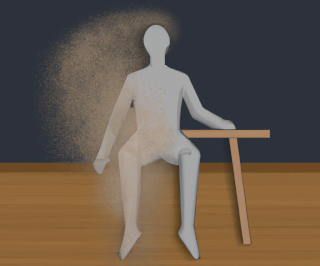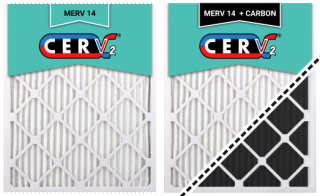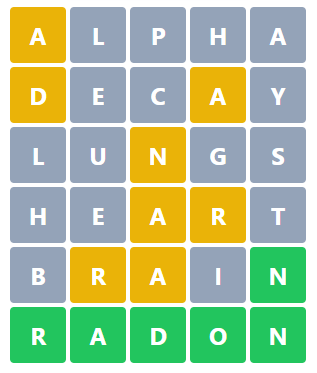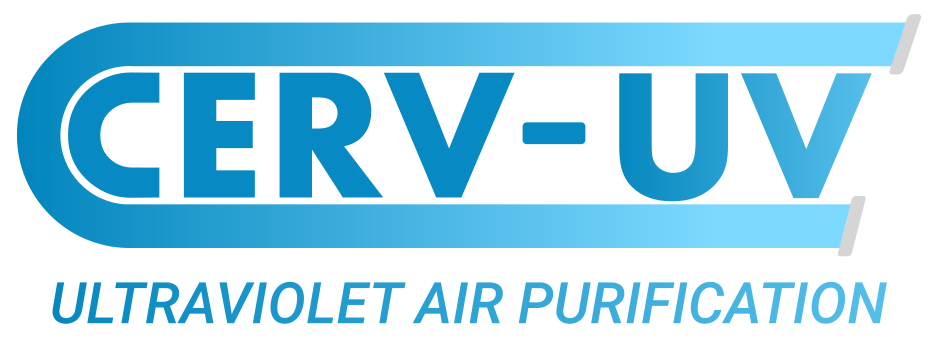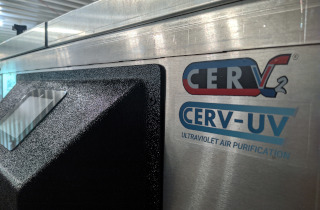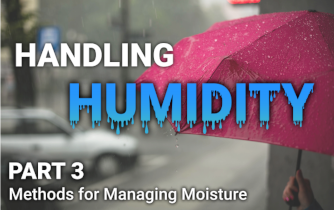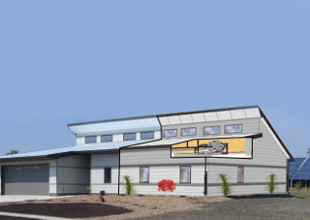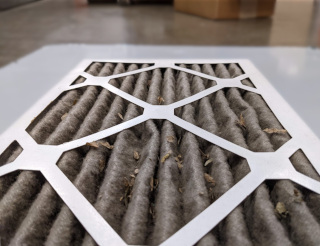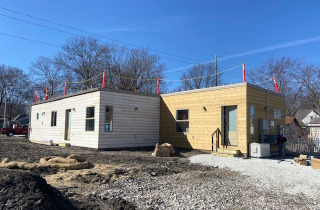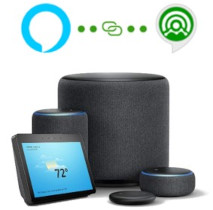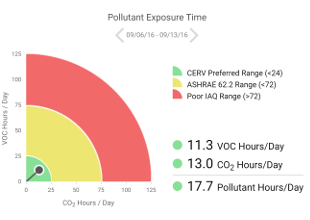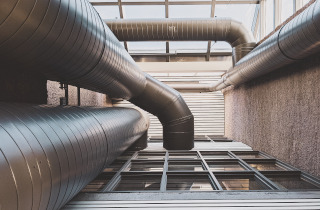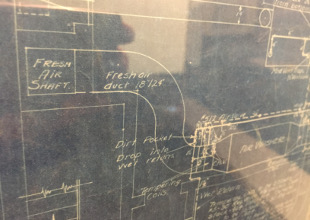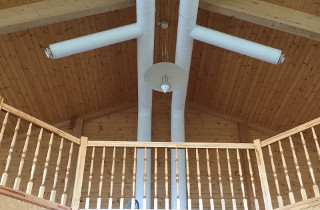CERV2 Frequently Asked Questions
‹ Return to CERV2 OverviewSearch FAQ
Air Quality & Comfort
The CERV monitors the indoor air quality (CO2 and Volatile Organic Compounds – or VOCs), and automatically ventilates to keep your air fresh when it becomes polluted. When your air quality is good, the CERV doesn’t unnecessarily ventilate, saving energy. This results in better air quality, with lower energy consumption than a typical ERV/HRV.
The sensors for the CERV are located inside the system, underneath the Return Air Filter and Fresh Air Filter. By measuring at the system, the CERV is able to get an idea of the whole-house comfort and air quality.
Remote Temperature & Relative Humidity and T/RH/CO2 sensors are available for homes where more precise air quality control is needed.
You can’t have great air quality if you don’t have great filtration! The CERV comes standard with MERV13 filters, with more filtration options (MERV14, carbon, VOC-capturing, etc) available in the store. The CERV plays an important role in filtering the incoming fresh air, while also providing the opportunity to filter the existing inside air through its Recirculation Modes. If the CERV doesn’t need to ventilate the home, it can spend time recirculating air throughout the home and pulling out particulates.
Throughout many parts of the country, Radon management is of great concern. Can the CERV reduce radon in a home? Absolutely; read our article linked below!
Does the CERV measure and actively control Radon? This is where things get more complicated. Many states have strict regulations on Radon Mitigation (certifications, calibration, etc), which make it difficult to integrate as a core function of the CERV. Often, the best Radon mitigation measures are preventing Radon from entering the home in the first place, such as sealing floor cracks or installing a sub-slab depressurization system.
Ultraviolet air sanitization is a proven method of killing viruses and bacteria (FDA Page). With the global spread of COVID-19, Ultraviolet air sanitization has become a great tool to help prevent the spread of illness, and the CERV can harness that technology to help keep your family safe.
The CERV can be purchased with the integrated CERV-UV add-on, which has the added effect of not only sanitizing the air, but even preventing biological growth on your filters
Absolutely! Even though you might have a high rate of infiltration in your home, there’s no guarantee that it’s fresh! Think of where air leaks into your house – gaps and cracks around the window sills and rim joists, or even worse: holes that pests have made to get into your home.
When the CERV delivers fresh air into your home, you know it’s fresh and filtered.
Related Articles
The CERV has several options for managing humidity.
Summer Humidity
When the CERV brings in hot, humid fresh air from outside, it will ensure that the fresh air is cooled and dehumidified before it enters your home. If additional dehumidification is needed, the CERV can also control an external dehumidifier (see article below).
Winter Dryness
Since the CERV only ventilates when necessary, it can help keep your house from drying out in the winter. Many other ERV/HRV systems run at a constant low flow, meaning that they will be bringing in dry air from outside, even when your air quality is totally fine. If additional humidification is needed, the CERV can also control an external humidifier.
Related Articles
If the air quality in your home is good, the CERV can contribute a bit of bonus heating or cooling to your home using its highly efficient heat pump. Not only does this help ease the load on your other conditioning system(s), but the recirculation will help filter the air and unify comfort throughout the house.
Recirculation Cooling
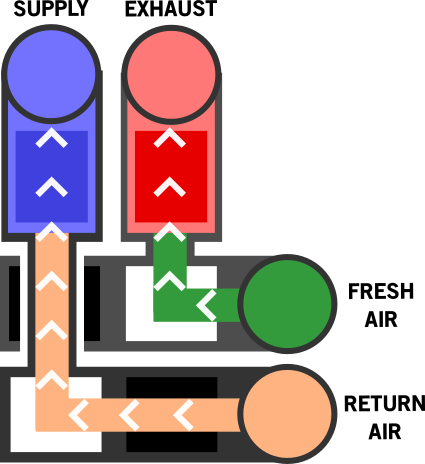
Outdoor air is heated, then exhausted back outside.
Recirculation Heating
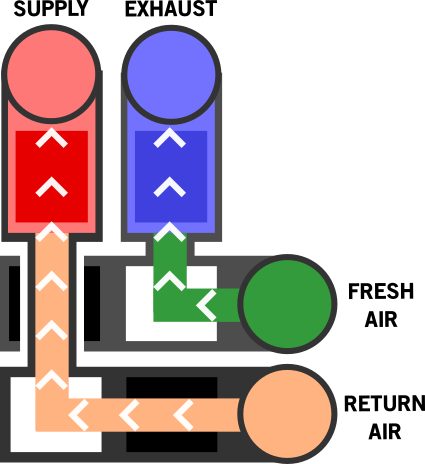
Outdoor air is cooled, then exhausted back outside.
Energy
You may be familiar with an how an ERV or HRV typically works – Exhausted air from inside and fresh air from outside go through a heat exchanger (core or wheel), transferring energy between air streams and partially heating or cooling the incoming air. The CERV is different.
Instead of using a core or wheel to transfer energy, the CERV uses its internal air-to-air heat pump. This allows the CERV to recover energy at a higher efficiency than other ERV and HRV systems. When delivering fresh air into a home, the air will be warmed in the winter, and cooled/dehumidified in the summer.
Ventilation With Cooling/Dehumidification
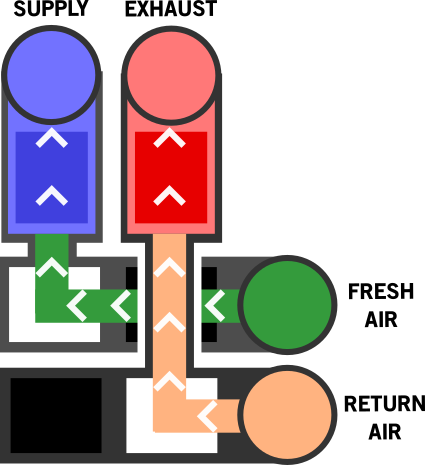
Outdoor air is cooled and dehumidified, then supplied to the living spaces.
Ventilation With Heating
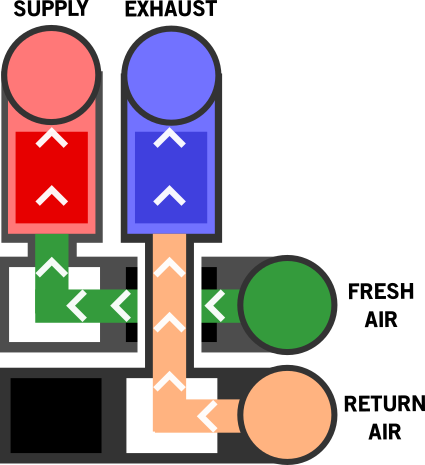
Outdoor air is heated, then supplied to the living spaces.
When comparing the CERV to a traditional ERV/HRV, it’s not always apples to apples.
Efficiency %
An ERV or HRV will list its efficiency as a percentage of the energy moved from the exhausted airstream into the incoming fresh air stream. These numbers will range from around 75% for mid-level systems to 90% for some of the higher tier systems. Since the CERV uses a heat pump to exchange energy and condition the air, it can actually have a recovery efficiency of over 100%!
Modeling
Simply put, most energy modeling software is incapable of properly characterizing the CERV’s operation. How many people are home? Are you cooking? Exercising? Reading? Do you have pets? The CERV is a dynamic system that responds to ventilation needs on demand. Check out our “7 Steps for Designing an Economical Net Zero Home” below to learn more about how the CERV can be modeled with our free ZEROs software.
Put very-very simply: If the CERV was to run continuously at maximum power, you’d be looking at around $1.00-$1.50 per day worth of energy cost.
Now ask yourself the following – what are the dollar savings of one less doctors visit? What is the monetary value of better sleep? What’s the price you put on the peace of mind that your air you breathe is clean and healthy?
Related Articles
The CERV’s heat exchangers are built to handle frost – heck, that’s extra energy to capture! The CERV’s internal defrost algorithms are intelligently designed to only defrost when necessary, and otherwise keep pumping out heat. The CERV has no low-temperature operation limit, so you can keep your air fresh even when it’s cold out.
There are many conditions that you don’t want to recover heat! Think of a cool summer night – why would you heat up the incoming air by exchanging energy with your warmer exhaust air? The CERV uses its array of sensors to determine the optimal energy path to keep your house comfortable. When outdoor conditions are better than inside, the CERV can use its Free Heating or Free Cooling modes to help condition the home with super high efficiency.
Integration & Smart Controls
Every home HVAC configuration is different, and we’ve made sure that the CERV can play nice with others! The CERV has several ways of interfacing with external devices, from simple fan interlocks (CERV’s internal dry contact, I/O expansion board, or wireless relays) to thermostat interfaces (CERV-IR-T).
You can learn more on the CERV’s Options Page.
Related Articles
The CERV was designed to be flexible in your home. The CERV allows for up to 4 hard-wired inputs (dry contact sense or 24VAC sense) and up to 18 wireless options (wall switches, active circuit transmitters, occupancy sensors, T/RH/CO2 sensors, etc). Each device is uniquely identified, and can be configured with its own custom fan speed, ventilation duration, and zone (if applicable)
More Information on the CERV’s inputs can be found in the Appendix of the Installation Guide, and the CERV I/O Expansion Board Manual.
Related Articles
The number of various Smarthome platforms and protocols to choose from can be dizzying (and ever-changing)! While the CERV does have online control and Alexa Skills, we are still working on integrating with the various Smarthome platform APIs.
To control the CERV with your Smarthome platform, consider using one of the CERVs auxiliary inputs or wireless devices. The CERV allows for up to 4 hard-wired inputs (dry contact sense or 24VAC sense) and up to 18 wireless options (wall switches, active circuit transmitters, occupancy sensors, T/RH/CO2 sensors, etc). If your Smarthome platform can open and close a dry contact, it can control the CERV using one of its inputs!
More Information on the CERV’s inputs can be found in the Appendix of the Installation Guide, and the CERV I/O Expansion Board Manual.
The CERV comes with Wi-Fi built in, with a replacement Ethernet Adapter available for those who would rather have the CERV hard-wired. Once the CERV has been connected to your network, you can log in to CERV-ICE through your computer, smartphone, or tablet.
CERV-ICE allows you to control your CERV from anywhere in the world, and gives you the ability to view historical comfort and air quality data in convenient, easy to read graphics. Best part? It’s free!
Related Articles
The CERV uses a low-power local wireless protocol for interfacing with its wireless options, and generally have indoor range of approximately 80ft (24m). Home construction materials can vary this range – brick and metal can significantly degrade the signal range. In cases where this may be an issue, wireless repeaters may be placed in the home (simply plugged into a standard power outlet) to boost the signal.
CERV Operation
The CERV’s Filters should be replaced every three months (or sooner, if needed). The CERV interface features a filter notification reminder, and the CERV-ICE online interface can be configured to send you email alerts when it’s time to replace your filters.
Affordable replacement filters can be purchased from the Build Equinox’s Store. In addition to the standard MERV13 OEM filters, check out our Carbon Filters, VOC Absorbing Filters, and MERV 14 Filters!
The heat pump inside the CERV is designed to be whisper-quiet, and often can’t be heard when operating! There may be a noticeable small vibration from the system, so if the CERV is installed above living spaces, it’s recommended to place the unit on rubber vibration isolation pads.
Duct noise should be carefully considered when designing the ductwork for the CERV. While the CERV does use high quality, quiet ECM fans, restrictive ductwork can lead to higher air velocity resulting in more duct noise.
To reduce duct noise, consider using our Inline Duct Silencer on the supply outlet of the CERV.
The System
The CERV’s performance characteristics can be found on our Specifications Page.
The CERV is manufactured in Monticello, Minnesota. Build Equinox Headquarters is located in Urbana, Illinois.
The CERV has a 5 year Warranty:
Year 1: parts & labor
Years 2-5: parts only
Planning / Design
You’ve gone through a lot of effort to tightly seal up your home, so stop cutting all those holes for bathroom vent fans! The CERV can easily manage bathroom odors and moisture, ensuring that energy is captured and recovered when these spaces are vented.
The CERV can be automatically triggered into ventilation mode through the use of our wireless occupancy sensors, active circuit transmitters, battery-free wall sensors, or even remote humidity sensors.
For even more precise pollutant control, consider using our array of wireless sensors and switches along with zone dampers. Learn more about these kind of capabilities in the article below.
Related Articles
In many cases, the CERV is capable of providing kitchen ventilation. The CERV may be automatically triggered into ventilation mode using the CERV’s Active Circuit Transmitter wireless option connected to the vent-hood.
In a home with an electric cook-top, and recirculating vent hood, a CERV return may be placed in the kitchen to remove pollutants. The recirculating vent hood will help trap grease and larger particulates, preventing those from dirtying up the ductwork to the CERV. A kitchen vent hood should never be connected directly to the CERV!
In a home with higher cooking ventilation airflow requirements (such as gas cooking), a direct vent should be used. If the kitchen vent is less than 400cfm, the CERV can be used to provide make-up air to the kitchen.
See these details and more in the article below.
Related Articles
The CERV is incredibly flexible, and can have its own dedicated ductwork or share ductwork with another system. See the Ducting section in the Installation Manual for diagrams and more information.
For a real-world example of the CERV ducted to a central system, see the related article below.
Related Articles
We do not recommend that the CERV be relied upon for the entire conditioning of a home. The CERV’s ability to supply heating or cooling to a home is significantly impacted by the occupants and activities in the home. When the CERV is ventilating, it may be using its entire capacity to heat or cool the incoming fresh air, without having spare leftover to provide the bulk conditioning necessary to keep the home at a set temperature.
For homes with very low loads, requiring around 1-ton (12kBTU) heating/cooling capacity, consider using the CERV’s Magic Box Mechanicals concept (see Related Article below).
Related Articles
Smaller than 2400sqft
The CERV will work great for managing air quality!
2400sqft – 5000sqft
The CERV will work great for managing general air quality, but Zone Dampers should be used with the CERV to quickly remove moisture and odors from bathrooms and kitchens.
Larger than 5000sqft
Multiple CERVs are recommended.
For homes above 2400sqft, it’s strongly recommended to use zone dampers with the CERV to quickly remove moisture and odors from bathrooms and kitchens. A variety of wired or wireless options may be used to trigger the CERV to ventilate specific zones (for example, an Active Circuit Transmitter may be used to tell the CERV to ventilate the Guest Bathroom when its light is turned on).
For smaller homes, zone dampers are not required but can provide a benefit in efficiency of pollutant removal. See the Related Articles below to see examples of how to zone bathrooms and kitchens.
Related Articles
While we do not create duct design layouts, if you have a preliminary duct designs, we are happy to review the plans and offer recommendations. To get started, fill out our Contact Form.
Related Articles
Ordering
Build Equinox bypasses the typical distribution structure (saving you cost from markups), and provides the opportunity for the CERV to be purchased directly from us. Contact Us to get pricing and ordering information.
While the CERV is primarily sold in the United States and Canada, arrangements can be made for other countries. Contact us to work out the details.
Contact us to for an up-to-date pricing sheet for the CERV and its options.
Contact us, and tell us a little bit about your project. We like to learn about our customers projects and make sure that the CERV’s potential is maximized!
4-6 Weeks is the standard lead time for a CERV order.
Installation
The CERV can be installed by any HVAC or Mechanical Contractor who is familiar with ERV/HRV systems. The Installation of the CERV system is extremely straightforward – the CERV is set in place, ductwork connected (standard 8″ round ducts), condensate line connected (3/4″ pvc), and then plugged into an electrical outlet. No special certifications are needed for the installers.
The CERV should be installed in a conditioned space with relatively easy access. Typically, this would mean a utility room, basement, or insulated attic space. The minimum installation area around the CERV is 62″ x 27.5″ x 42″, to provide access to change filters and check the condensate drain.
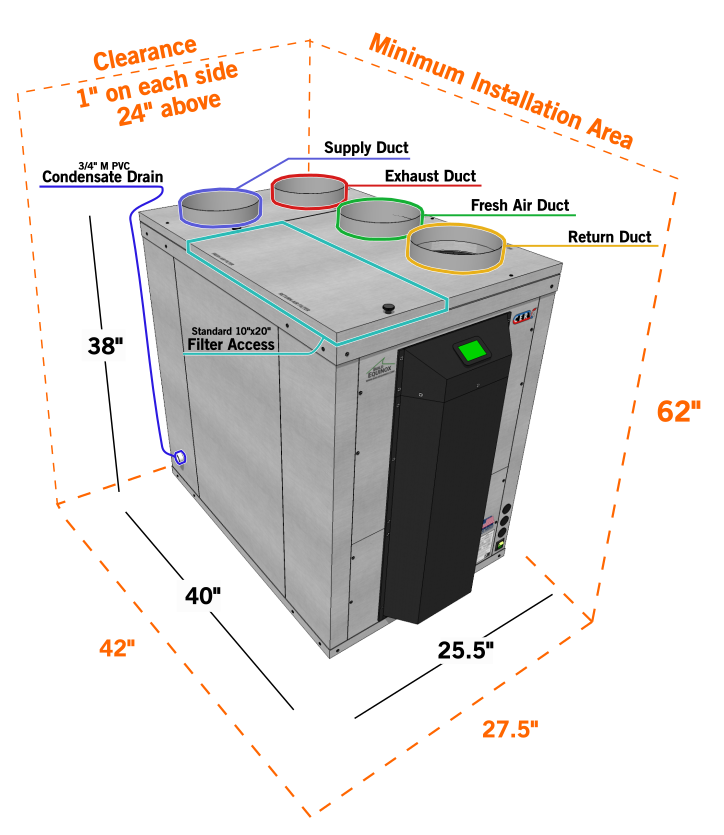
While the ductwork may be installed early on in the construction process, it is recommended to wait to make the final connections to the CERV until drywall and painting is finished. During drywall and painting, all duct registers should be covered and the CERV kept off.
The CERV has four 8″ rigid duct connections on the top of the unit. We typically recommend 8″ ducting for the main supply and return trunks, then reduce to 6″ for the branches to individual registers. Remember, larger ductwork results in less noise, lower fan power, and more capacity to move air. It’s better for your ductwork to be oversized than undersized.
Flex duct may be used, but care must be taken to ensure that the ductwork is kept straight without sharp kinks or sags. In installations where there is a short distance between the CERV and the exterior intake/exhaust registers, pre-insulated flex duct can be economical and convenient.
All ducts except for the RETURN (from inside) must be insulated. It is recommended to use a minimum of R4.0 insulation for supply to the inside and R8.0 on the ducts to and from the outside. In colder climates, it may be necessary to add additional insulation if it appears that the ducts may be showing signs of sweating.
Inlet and exit vents should be a minimum of 4’ apart in any orientation. Inlet separation from any other possible sources of contamination should be considered and local codes followed.
Outside wall vents must be sufficiently above ground to avoid blockage from snow or other obstructions. Two feet above ground is recommended. The vents should have a coarse screen or mesh to prevent insects, birds, etc from entering, but fine screens, dampers, flaps, etc should be removed so as to eliminate any restrictions. Recommended wall vent: Mfr: Imperial, Part #: 6398901
If possible both inlet and exhaust should be on same side of house to avoid pressure differential, which can impact flow.
While unlikely, a condensate line clog could result in a potential water leak from the system onto the floor below.
For installations where water damage could be a possibility (i.e. finished spaces, attic, etc), an overflow pan should be placed under the CERV. If using a pan, the pan should also have a drain tube installed.
Recommended Drain Pan: DiversiTech 6-2739L
For added protection, a wet switch may be installed in the drain pan or base of the CERV. Consider the use of a product like the Hydro Check
WaterWatcher. The device will shut off the CERV, as well as sound an audible alarm if water is detected in the overflow pan.
The Installation of the CERV system is extremely straightforward – the CERV is set in place, ductwork connected (standard 8″ round ducts), condensate line connected (3/4″ pvc), and then plugged into an electrical outlet. Installation of the CERV itself should only take a few hours. By far, the more time and labor intensive component is the installation of ductwork, which varies from house to house.
Want to Learn More?
Begin Your Path to Healthier Air at Home
What you breathe matters. Poor air quality can have both short-term effects, and long-term consequences for your overall health. The CERV empowers you to take control by monitoring pollutants and maintaining a healthy, clean environment for you and your loved ones. Take the first step today toward a healthier home.
Step 1
Fill out the contact form.
Step 2
We'll reach out to get more information about your project and answer questions.
Step 3
We work together to help finalize the design and options.
Step 4
Get your CERV and start breathing fresh, healthy air!





